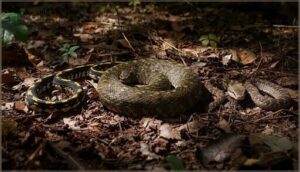This site is supported by our readers. We may earn a commission, at no cost to you, if you purchase through links.

Understanding how big garter snakes get and how long it takes to grow reveals more than numbers—it uncovers how habitat, genes, and food turn these snakes into survivors, each with a growth story shaped by the world around them.
Table Of Contents
- Key Takeaways
- How Big Do Garter Snakes Get?
- How Long Does It Take Garter Snakes to Grow?
- Key Factors Affecting Garter Snake Growth
- Garter Snake Growth Stages Explained
- Garter Snake Size Comparison by Species
- Frequently Asked Questions (FAQs)
- What is the size of a fully grown garter snake?
- When do garter snakes reach their full size?
- How big do Butler’s garter snakes get?
- How big should a garter snake vivarium be?
- How long do garter snakes live?
- How long should a garter snake be in a cage?
- How big is a full grown garter snake?
- Is it good to have garter snakes in your yard?
- Are garter snakes aggressive to humans?
- How big do garter snakes get?
- Conclusion
Key Takeaways
- Most adult garter snakes reach 18–26 inches, but some species, like the giant garter snake, can grow up to 65 inches.
- Females are typically larger than males, and a snake’s ultimate size depends on genetics, food availability, and environment.
- Hatchlings start out at about 5–9 inches long and can double their length within the first year, reaching full adult size by two to five years.
- Regional habitat, climate, and diet all play a huge role in how quickly and how large a garter snake will grow.
How Big Do Garter Snakes Get?
If you’ve ever wondered just how big garter snakes can get, you’re not alone. Their size can vary quite a bit, depending on the species and where you find them.
Let’s take a closer look at the kinds of sizes you might expect.
Average Adult Length and Weight
Most adult garter snakes fall into a typical size range, but there’s always some variation. Here’s what you’ll notice with Garter Snake Size and characteristics:
- Average adult length: 18–26 inches
- Heaviest adults: 150 grams or more
- Females are bigger (sexual dimorphism)
- Certain subspecies show sizeable size and weight variation
Snake size always depends on influencing factors. They’re the most common serpent in many regions.
Size Range Among Different Species
Garter snake species exhibit plenty of size variation. Some, like the Short-tail Alpine, barely top 20 inches, while the Giant garter snake approaches 65 inches at its peak. Even from region to region, snake size changes—the smallest garter snake often appears in high-altitude zones, while the largest garter snake is found in fertile wetlands. Their diet is carnivorous, and they often feed on local amphibians and insects.
| Species | Typical Length | Where Found |
|---|---|---|
| Giant Garter Snake | 55–65 inches | California wetlands |
| Eastern Garter Snake | 18–40 inches | Eastern U.S. |
| Northwestern Garter Snake | 16–24 inches | Pacific Northwest |
| San Francisco Garter | 35–39 inches | San Francisco Bay Area |
| Short-tail Alpine | 16–20 inches | Mexican highlands |
Record-Breaking Garter Snake Sizes
If you’re wondering just how large these snakes can get, some records will make you look twice. The giant garter snake hits maximum lengths near 65 inches—longer than some kids.
Remarkable snakes often turn up in rich wetland habitats, where the right conditions push growth records. Weight extremes are less dramatic, but size differences highlight fascinating garter snake characteristics across species.
How Long Does It Take Garter Snakes to Grow?
Garter snakes don’t stay small for long, and their growth can surprise you. Their size changes pretty quickly depending on age, food, and environment.
Here’s what to know as you look at different enclosure options.
Growth Timeline From Birth to Maturity
Think of the garter snake’s life as a series of yardsticks—each marking a leap in size and independence. Here’s your growth timeline:
- Hatchlings emerge at 6-8 inches.
- By spring’s end, most double in length.
- Steady growth brings juveniles up to 2 feet within one year.
- Full maturity arrives after consistent gains, reflecting unique growth patterns.
Age at Sexual Maturity
Maturity rates in garter snakes aren’t just numbers—they weave into their entire life cycle. Males are ready to mate by about 1.5 years, while females often mature closer to two. This sexual dimorphism means size and gender affect snake reproduction and growth patterns. Take a look at how these factors play out:
| Sex | Typical Age at Maturity |
|---|---|
| Male | 1.5 years |
| Female | 2 years |
Factors Influencing Growth Rate
Growth isn’t set in stone—it’s shaped by Genetic Factors, Environmental Impact, and Nutrient Intake. Warmer temperatures can accelerate snake growth yet may lead to smaller adults, while Hormone Regulation controls energy use.
Changes in Garter Snake Habitat, food quality, or temperature effects often show up in Garter snake size comparison and behavior, highlighting the adaptability in snake characteristics.
Key Factors Affecting Garter Snake Growth
A garter snake’s growth depends on a mix of factors, some you can control and some you can’t. Everything from its genes to the world around it plays a role.
Let’s look at the main things that shape how big your garter snake can get.
Genetics and Species Variations
Not all garter snakes are built the same—genetic diversity plays a big role in their growth and looks. Heritability estimates show traits like body size, stripe width, and coloration get passed on, shaping how different species appear.
Hybridization outcomes create unique blends of morphological traits, while evolutionary analyses reveal why garter snake size comparison varies across species and regions.
Environmental Conditions
Where your snake lives matters more than you’d think. Temperature effects drive growth rates, with best conditions between 68–85°F boosting activity and feeding. Humidity levels around 30–60% support healthy shedding, while habitat availability determines prey access.
Seasonal adaptations trigger hibernation in colder months, pausing growth entirely. Microclimate variation—like shaded forest floors versus open grasslands—shapes how efficiently garter snakes thermoregulate and grow.
Diet and Nutritional Impact
What you feed your snake directly determines its growth potential. Garter snake diet consists of earthworms (80% in eastern species), amphibians, fish, and small prey—all carnivores need varied food sources to meet nutrient requirements.
Feeding strategies matter: daily meals can boost juvenile weight by 285% over 13 weeks. Some snake species evolved dietary adaptations like toxin resistance to newts, though fish-heavy diets risk thiamine deficiency affecting growth.
Garter Snake Growth Stages Explained
Garter snakes go through distinct stages from birth to adulthood, and each phase brings noticeable changes in size and behavior. Understanding these growth stages helps you know what to expect as your snake develops.
Let’s break down how garter snakes grow from tiny newborns to full-sized adults.
Newborn Size and Early Development
Imagine this: at birth, garter snakes arrive ready for independence—no Neonatal Care or maternal influence, just pure instinct. These hatchlings measure about 5 to 9 inches in length, their slender frames reflecting diverse birth weights and Snake physical attributes.
Born ready for independence, garter snake hatchlings emerge alone and instinct-driven, measuring a slender 5 to 9 inches at birth
Within hours, they shrug off any early dependence and begin Early Feeding, launching their role in the snake reproduction and life cycle.
Juvenile Growth Patterns
Soon after those first feedings, Growth Rates in Snake Development accelerate. Juvenile Habits kick in fast: checkered garter snakes might stretch 10 to 15 centimeters a year, while plains garter snakes can grow over a centimeter each week at first.
Environmental Impact, Species Variations, and steady hunting shape Garter Snake Characteristics long before adulthood, setting the stage in the snake reproduction and life cycle.
Adult Maturity and Lifespan
After the rapid growth of youth, your garter snake’s maturity rates take center stage. Most reach adulthood by age two, with subtle but steady growth continuing.
Lifespan factors like habitat, predation, and the rigors of snake hibernation play a role—wild snakes often live 2 to 4 years, while captive care can stretch that to a decade.
Garter Snake Size Comparison by Species
Not all garter snakes are the same size, and there’s plenty of variety from one type to the next. Where they live can also play a big role in how large they get.
Here’s how different species stack up regarding size.
Eastern Garter Snake Vs. Other Species
Snake size variance isn’t just about numbers—it’s about adaptation and identification. The Eastern garter snake, usually 18–26 inches long, stands out with its sleek build and bold yellow stripes. Compare that with the bulkier giant garter snake or the more compact Thamnophis scaliger, and you’ll spot tangible differences in garter snake morphology and color pattern.
| Species | Average Length | Notable Features |
|---|---|---|
| Eastern Garter Snake | 18–26 inches | Slender; bright yellow stripes |
| Giant Garter Snake | 37–65 inches | Bulkier; olive-brown body |
| Thamnophis scaliger | 16–20 inches | Stout; subtle color patterns |
Geographic Variation in Size
Where a garter snake lives shapes its size. Northern populations usually reach longer lengths, thanks to cooler climates and wider habitats, while southern and high-elevation snakes often remain smaller.
Here’s how habitat size, climate influence, and regional trends stack up:
| Region | Habitat Size | Latitude/Elevation Impact |
|---|---|---|
| Northern U.S. | Large | Grows longer in cooler zones |
| Midwest Plains | Moderate | Size varies with rainfall/altitude |
| Mexico | Small-Varied | Higher sites, smaller averages |
Identifying Garter Snakes by Size
How do you spot a garter snake by size alone? Start with key markers: juvenile size ranges, adult length, and noticeable sexual size dimorphism—females tend to be a bit bigger. Pair these with color patterns and you’ll have a strong foundation for snake identification. Check the table below for a quick comparison of size-based identification cues.
| Feature | Example | Application |
|---|---|---|
| Juvenile size markers | 5-9 inches | Identify young snakes |
| Subspecies size ranges | 18-65 inches | Snake species ID |
| Sexual size dimorphism | Females larger | Distinguish sex/species |
Frequently Asked Questions (FAQs)
What is the size of a fully grown garter snake?
Believe it or not, a fully grown garter snake can reach an adult size of 18 to 26 inches on average, though some females—thanks to sexual dimorphism—stretch to nearly 36 inches, with their appearance noticeably slender but strong.
When do garter snakes reach their full size?
You can expect growth completion in most garter snakes between 3 and 5 years, though smaller species may hit full adult size closer to 5 or 2 years.
Size determinants include genetics, environment, and diet.
How big do Butler’s garter snakes get?
Picture a slender snake weaving through damp grass—Butler’s garter snakes reach an adult size of 15 to 29 inches, with most individuals staying below 20 inches.
Juvenile length starts at 5 inches, with noticeable size variation.
How big should a garter snake vivarium be?
For proper garter snake habitat, the minimum vivarium size is 48”x24”x24”. Prioritize escape prevention and include tall enclosure height. Scale up as your pet grows.
Add enrichment needs like climbing features to mimic natural snake behavior.
How long do garter snakes live?
Wild lifespan for garter snakes is often short, with high mortality rates from predators. Most live 2–4 years, though some reach sexual maturity earlier.
Captive longevity increases, sometimes exceeding 10 years. Geographic differences and maximum age records vary.
How long should a garter snake be in a cage?
Your garter snake should have a cage at least as long as the snake itself. Cage size minimums support activity levels, enrichment, climbing, and tank cleaning frequency—all key for a healthy pet enclosure and natural behavior.
How big is a full grown garter snake?
A full-grown garter snake averages 22 to 30 inches, with some reaching up to 65 inches for the largest species.
Adult size depends on genetics, species comparison, sexual dimorphism, weight factors, and overall garter snake behavior.
Is it good to have garter snakes in your yard?
Having garter snakes in your yard is usually a good thing—they help with pest control in gardens and lawns.
Their gentle nature means Backyard Snake Safety is rarely an issue, even for homes with pets or children.
Are garter snakes aggressive to humans?
Imagine a defender in a tiny striped suit, more keen on escape than a showdown. Garter snakes, nonvenomous snakes by nature, rarely show aggression to humans. Defensive behavior like snake bites mostly happens only if cornered or handled.
How big do garter snakes get?
Depending on species and habitat influence, snake length variations span from 18 to 65 inches.
Most Garter snakes clock in at 18–26 inches, with genetics and morphology factors shaping growth patterns and overall Garter snake characteristics.
Conclusion
Imagine a garter snake growing so fast it nearly jumps out of its old skin, dashing from the size of a shoelace to a creature as long as your arm. That’s the extraordinary story behind how big garter snakes get and how long it takes to grow—each snake shaped by food, genes, and habitat.
If you spot one slipping through your garden, you’re witnessing a survivor determined to outgrow every limit nature dares to set.












